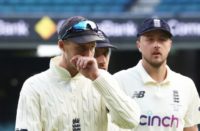Granted Joe Root was precisely four Tests and a handful of ODIs into his England career, but I still never thought he’d really go for it.
He’d been happy enough to talk about falling victim to that knavish prank through which, inadvertently, he had earned his first nickname.
His Yorkshire team-mate Anthony McGrath was the chief suspect, alleged to have filled out, on Root’s behalf, the usual questionnaire, sent to all counties by the publishers of the 2013 edition of The Cricketers Who’s Who, as follows: “Surprising fact? Auditioned for a Milky Bar Kid advert but narrowly failed to land the part.”
Indeed, not only did the young shaver find it funny but also useful because, as he said, though he was 22 years old by then, when he looked at TV highlights of his debut performances in India and New Zealand the previous winter even he couldn’t quite believe how young he looked, and if that callow appearance deceived opponents into underestimating him, so much the better.
But while I did think asking him to pose for photographs holding an actual Milky Bar was going too far, he had no qualms whatsoever.
Unless we are all reading the signs wrong, he has retained that incredibly mature characteristic of self-deprecation ever since.
And we were reminded of just how completely the Milky Bar Kid has grown into the man when reviewing the images of him consoling the inconsolable Ben Stokes after the harrowing shared experience of witnessing Carlos Brathwaite smash the first four balls of the last over of the World T20 final into the Kolkata night air to crush England’s hopes of being crowned kings of the shortest form of the international game.
Until that point, Root had been the undoubted star of England’s show. Had they won he would certainly have been named man-of-the-match.
Going to the wicket to face the third ball of the innings, he watched Alex Hales follow Jason Roy back to the hutch in the next over at 8 for 2 and, as England batted like a car that kept stalling, saw Eoin Morgan, Jos Buttler and Ben Stokes come and go as the pressure of the occasion made a nonsense of the “no fear” approach that had got them thus far.
Yet he had kept finding ways to keep the scoreboard moving, first punching Sulieman Benn for three fours in the fourth over, then taking regular boundaries with risk-free examples of the skill that had Sanjay Manjrekar, one of the masters of the art, purring: “The thing about Joe Root is that he hits the ball between the fielders.”
He finished with yet another half-century to confirm once again, should such confirmation be required, that he is, beyond dispute, not only England’s best batsman, but the toughest – the quality that has enabled him to claim a place in the top ten of the world rankings in all forms – No.2 in Tests, No.10 in ODIs and No.4 in T20s.
But as the third of three batsmen to fall for one run in four balls to leave his side 111-7, he would have been kicking himself all the way back to the dug-out.
Then, with everyone present at Eden Gardens, particularly the West Indies batsmen, convinced England’s final total of 155 was nowhere near good enough to hold off the coming onslaught from their power-hitters, Root stuck his hand up to bowl the second over of their reply, and struck twice in three balls to give his side the sniff of a chance of proving them wrong.
And what balls he came up with, giving the first one to Johnson Charles so much air that the batsman simply couldn’t stop himself trying to launch it over the ropes and ended up placing it softly into the hands of Stokes at long-on.
Even if Root had the cojones to try again, surely Chris Gayle wouldn’t fall for a second rope-a-dope?
But that is exactly what the ‘Universe Boss’ did, slapping the same ball even higher, but, just as unerringly, into Stokes’ grateful buckets.
And the true measure of Root was what we saw in the moment of England’s utter despair, when the match had been dragged from their grasp in the final over.
Amid the carnage, there he was, on his haunches, crouching next to his mate, arm draped around his shoulder, feeling every feeling his stricken colleague was going through, and, in that instant, you knew that all he had achieved personally in the match (54 runs and 2-9) and the tournament (249 runs at a ridiculous 49.8, and a scoring rate of just under 150 per 100 balls) meant less to him than nothing at all.
Three years and four months separate Root’s first match for England and his latest, but not much distance as they were both played on the Sub-continent.
Then, in December 2012, the young Tyke, batting at No.6, went to the crease with England in strife at 119-4 on the first day of the fourth Test in Nagpur, and their prospects looked even gloomier when Kevin Pietersen fell at 139-5.
But Root showed maturity beyond his looks to chisel out 73 from 229 balls and, by the time he was out, had helped drag England past 300 to help set up a position from which they were able to achieve the draw that clinched their first series win there since 1984.
Now, after his brilliant but ultimately doomed performance in the World T20 final, there is no player on the planet for whom England would even consider a trade, in any form of the game.
Maybe a two-for-one swap, but then again …
In time, Root will become England’s Test captain and most probably their ODI and T20 leader, too.
His performance in the midst of his greatest disappointment, with bat, ball and by Stokes’ side, confirmed they could not be in better hands than those of the Milky Bar Kid who became the man.
This piece originally featured in The Cricket Paper, Friday April 8 2016












